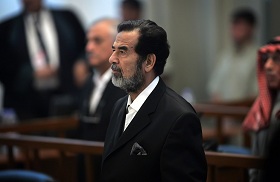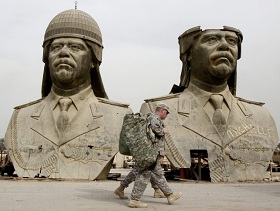The 2003-2012 war in Iraq has been the first 21st Century large-scale U.S.-led military operation against a state with a comparatively advanced defense infrastructure and economy. Although in the long run Washington has failed to attain its all practical political aims, it is definitely the victor, as the American troops were triumphantly withdrawn in December 2012.
Today, marking the Iraq war's anniversary, we shall once again attempt to analyze the U.S. experience, primarily in terms of its potential impact on the military evolution of NATO.
The 2003 War
Most past campaigns ended with seizure of the enemy capital, dismantling of its military and state institutions, and occupation of the major residential and industrial areas. As far as the 2003-2012 Iraq war is concerned, the one-month-long operation in 2003 was only a prologue to a lengthy armed conflict.
The initial stage was a complete victory for the West, with the Iraqi strength of 375,000 against coalition forces of just 173,000.
The technological gap was not as wide as in Afghanistan, where NATO faced poorly-trained and scantily-equipped Taliban troops formed less than 10 years before. The Iraqi army had had large-scale war experience, appropriate financing and trained personnel, as well as almost 6,000 armored vehicles and 300 aircraft. The defenders also displayed reasonably high morale, as Americans faced dogged resistance even during the offensive on Baghdad when the Iraqi defeat appeared imminent.
The U.S. coalition edge came from well-trained men, competent employment of aviation, and surprise strikes that disorientated the Iraqis. Quite significant were errors by the Iraqi commanders who over-dispersed the troops, and ordered fire at inappropriately long distances, as well as anti-air camouflage of troops to the detriment of their combat efficiency.
As a result, the Iraqi army was promptly beaten, suffering losses many times greater than those of the coalition contingents. In April 2003, Baghdad was seized, Saddam Hussein fled, and many in the U.S.A. believed the deed was done. The occupation troops were supposed to focus on purely technical issues like support of the emerging state institutions.
However, the reality was different.
The Guerilla War
The U.S. troops had already faced "residual" armed hostilities after defeating the main enemy forces in Afghanistan. But the resistance was weak, with one or two terrorist attacks a day against the ISAF in 2002, mostly brief shooting attacks on patrols and road mining with no casualties. Later, terrorism snowballed into a major problem.
In Iraq, intensive guerilla warfare came into being right in the first year of the invasion. The occupation authorities registered 10-35 terrorist attacks a day in 2003, 25-80 in 2004, and 65-90 in 2005 [1]. In total, in 2003-2005 almost 2,400 foreign troops and up to 40,000 Iraqis were killed. The civilian casualties seem grossly underestimated, as many researchers suggest much higher figures for direct and indirect losses.
According to some data, soon after the start of the guerilla war in 2003 the number of active combatants reached 20,000 and totaled 100,000 with collaborators, depot and safe-house holders, and makers of improvised explosive devices. The crowd included Ba'ath party members, radical Islamists and Iraqi nationalists, who formed groups of up to 12 militants to launch fire and mine attacks on American military convoys and patrols [2].
When the Shi'ites stepped in, attacks rose to a new level. In order to suppress the Fallujah uprising, the invading forces had to stage a series of air-supported operations that caused numerous civilian casualties.
The political package included establishment of the national transitional government in 2004 and parliamentary elections in 2005, both of which proved unproductive. The conflict was getting more confusing as a lot of terrorist activity moved to the infighting between the Shi'ites and the Sunnis, both of them eagerly assaulting the occupation troops.
Due to these failures and heavy military and civilian losses, support for the Iraq war in the Western countries was shrinking – during 2003 its approval level in the U.S.A. fell from 76 percent in April (after seizure of Baghdad) to 47 percent in October.
The need for fresh policies in solving of the Iraq conundrum became obvious.
The New Way Forward
In 2007, President Bush proclaimed the new Iraq strategy titled "The New Way Forward" dubbed by the press as the "surge" since it implied bringing in 30,000 more troops. Launching this policy in Iraq in 2007 and in Afghanistan in 2009-2010, Washington declared that it was basically aimed at "winning the hearts and minds" of the local population. However, the Americans had already vigorously used economic, political and propagandist mechanisms before the policy change, with the key innovation being in the modified set of military and police arrangements.
Before the changes, occupation forces in Afghanistan and Iraq had been quite passive, spending most of the time at their bases to guard against terrorists, with occasional outside patrolling and roadblock operations.
Criticizing the strategy of his predecessors, ISAF Commander General Stanley McChrystal wrote that “pre-occupied with protection of our own forces, we have operated in a manner that distances us – physically and psychologically – from the people we seek to protect." [3]
The new approach meant fewer airstrikes against the combatants because of excessive collateral losses among the civilians, and expansion of the ground infrastructure to protect districts in Baghdad and other terrorist-infested areas. Naturally, political resolve was to be bolstered by additional 30,000 troops, as was the case both in Iraq in 2007 and Afghanistan in 2010.
This temporary reinforcement was intended to help stabilize the situation and allow the national security forces to restore control.
In 2007, military fighting in Iraq peaked, with occupants' casualties reaching the record of almost 1,000 servicemen. The apex was followed by an abrupt drop in military and civilian casualties, i.e. a three-fold decrease during the first year. Militants' attacks in Iraq also went down, as the last major strikes took place in 2008.
As a result, Washington declared the final handover of security obligations to the Iraqi authorities. In 2009, foreign troops moved out of the cities for good, leaving their defenses to the national police, and in 2010 they officially gave up direct participation in combat. The gradual troops' withdrawal continued until late 2012, when the American flag was symbolically taken down in Baghdad. Yet technically the war had been won back in 2008-2009.
Some Conclusions
The Iraq war has shown that following a swift victory the winning army is likely to face greater difficulties, i.e. resistance by mobile guerilla groups, as happened in Afghanistan and seems to be surfacing in Mali, although on a lower scale.
No matter how strange it may seem, the U.S. technological edge and extensive use of aviation were no good at suppressing the Iraqi guerilla movement. Both in Afghanistan and Iraq, Americans had to employ essentially primitive tactics based on tightened military police control of the occupied lands, establishment of additional bases, and enhanced patrolling, with the key being additional troops.
Hence, Afghanistan and Iraq show that counterinsurgency may require many more troops than the preceding blitzkrieg. Counter-guerilla warfare should involve both offensive and defensive operations, the latter including permanent control of the occupied territory defined mostly by the strength and activity of ground forces rather than the technological advantage or skills. A large-scale air-supported offensive is likely to be ineffective except for the cases when the enemy attempts to seize populated areas. Mobile Special Forces groups prove more effective for exposure and destruction of depots and training bases, as well as for elimination of field commanders.
The threat of an extended guerilla war involving numerous troops and risking the lives of personnel is likely to become the key restraint for industrialized states eager to accomplish their geopolitical tasks by bringing troops into foreign territories.
The Iraqi precedent also shows that a vigorous guerilla movement may cut short the political ambitions of the occupying country. There has been no privatization of Iraqi oil fields. While they are being developed by foreign corporations, the property rights are reserved by the state, although U.S. interest in local oil was widely believed to be the main reason for invasion [4]. Iraq still has neither permanent NATO bases nor a pro-American government.
However, Washington has fully achieved its declared goal of toppling the Saddam regime. The economically and demographically emasculated Iraq is not likely to oppose the U.S.A. in the region any time soon. Therefore, the United States seems the outright winner, while the blame for the limited benefits falls on the politicians and not the military (who must have learned their own lessons from the arduous confrontation).
1. Eisenstadt M., White J. Assessing Iraq Sunni Arab Insurgency // U.S. Marines and Irregular Warfare, 1898–2007: Anthology and Selected Bibliography. Compiled by Evans S.S. Quantico: Marine Corps University Press, 2008. P. 270.
2. Eisenstadt M., White J. Assessing Iraq Sunni Arab Insurgency // U.S. Marines and Irregular Warfare, 1898–2007. P. 259–260.
3. McChrystal S.A. Report on Commander Initial Assessment to Gates R.M. August 30, 2009. P. 1–2.
4. Klare M.T. Blood and Oil: The Dangers and Consequences of America’s Growing Dependency on Imported Petroleum. N.Y.: Owl Books, 2005.








